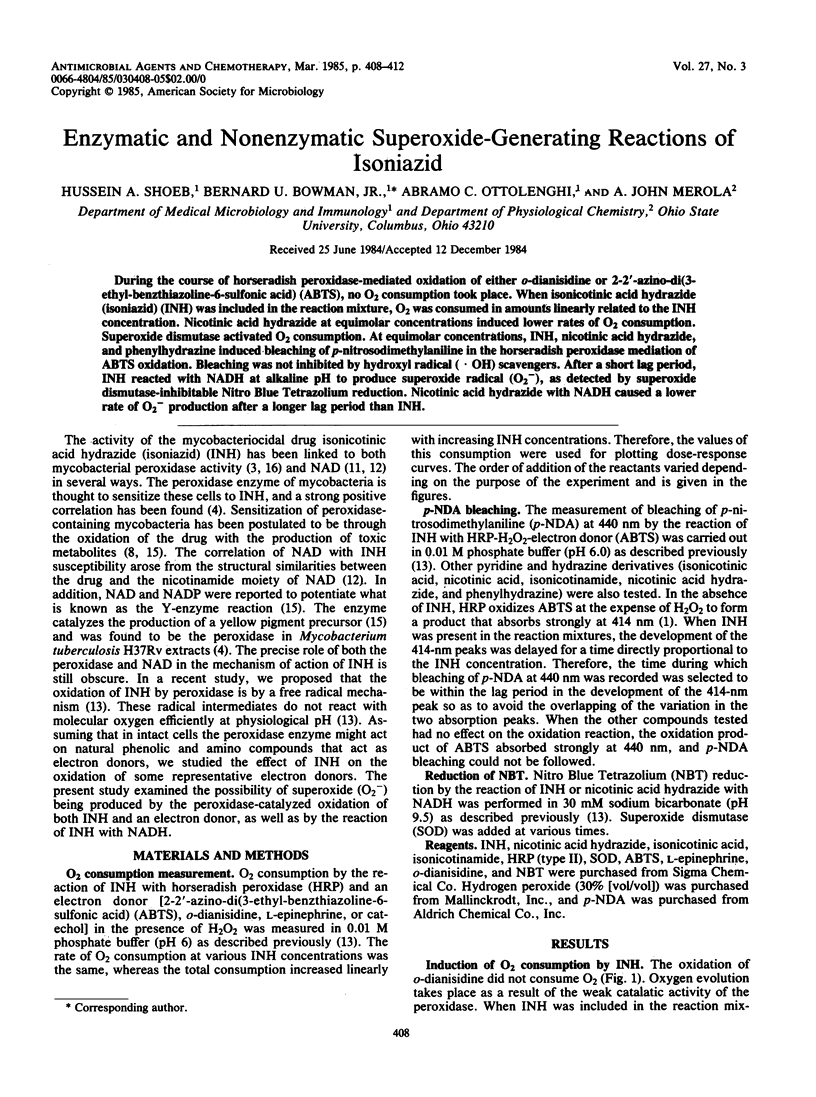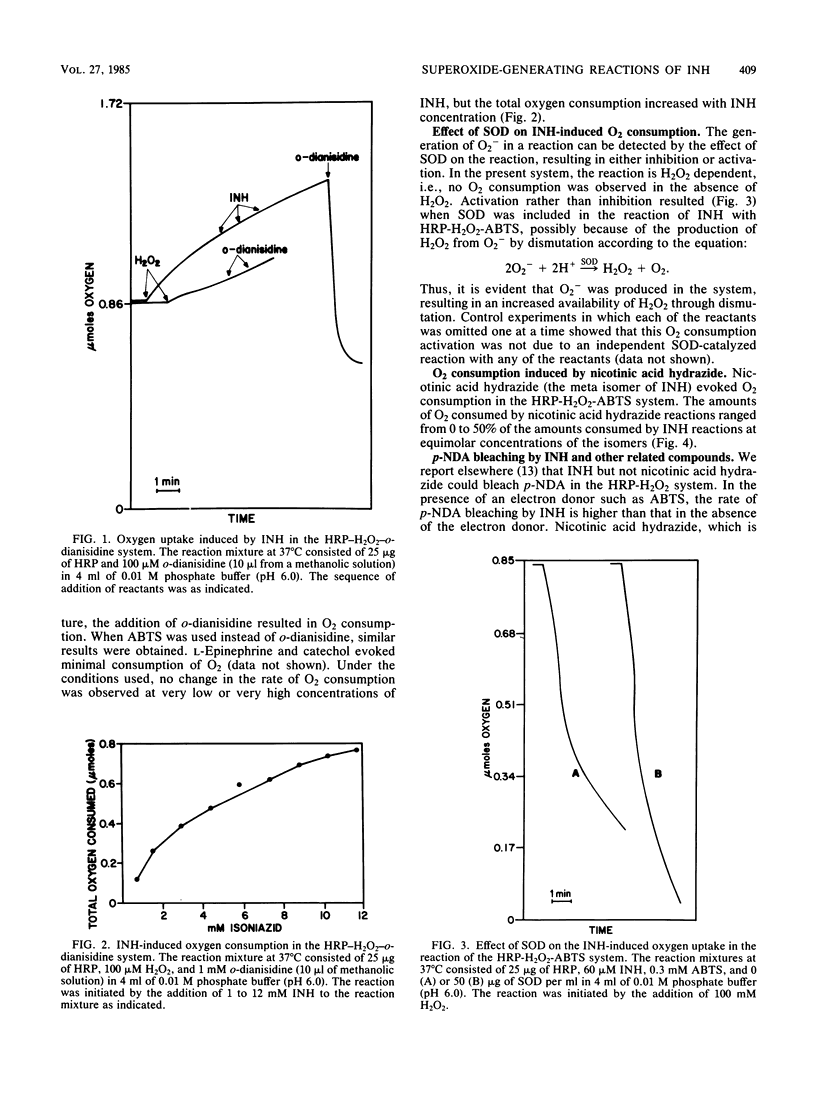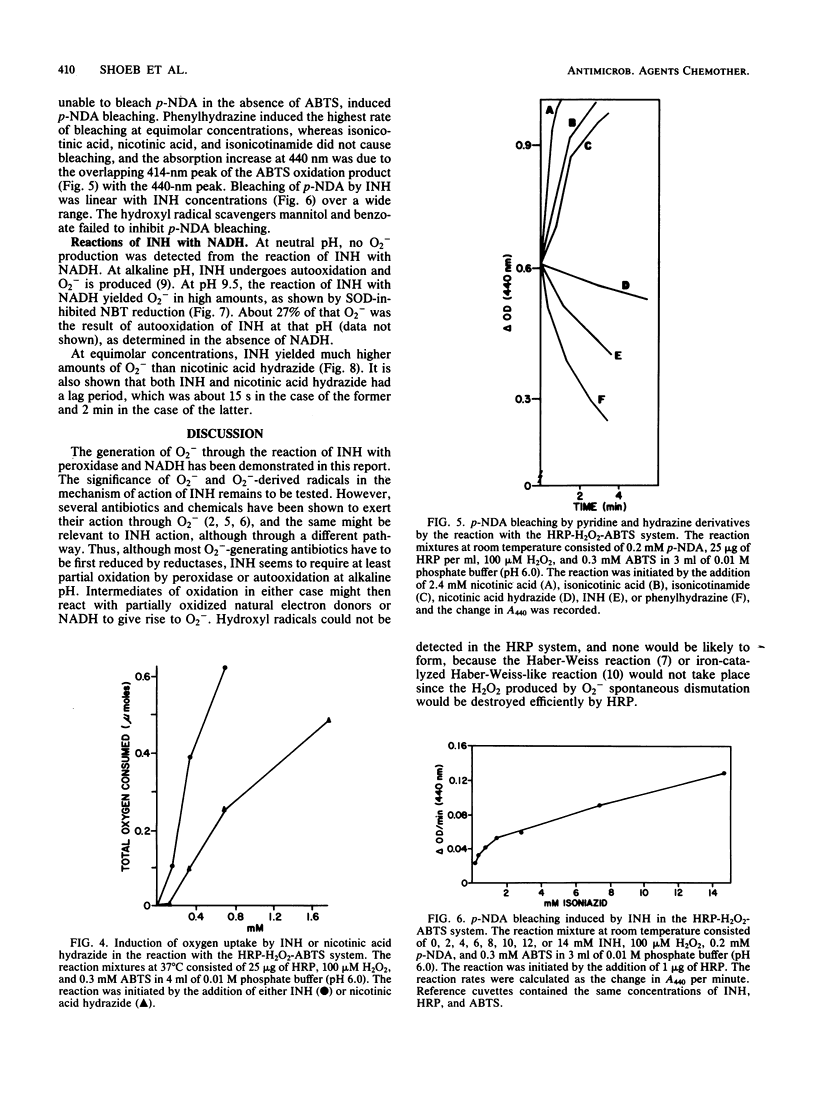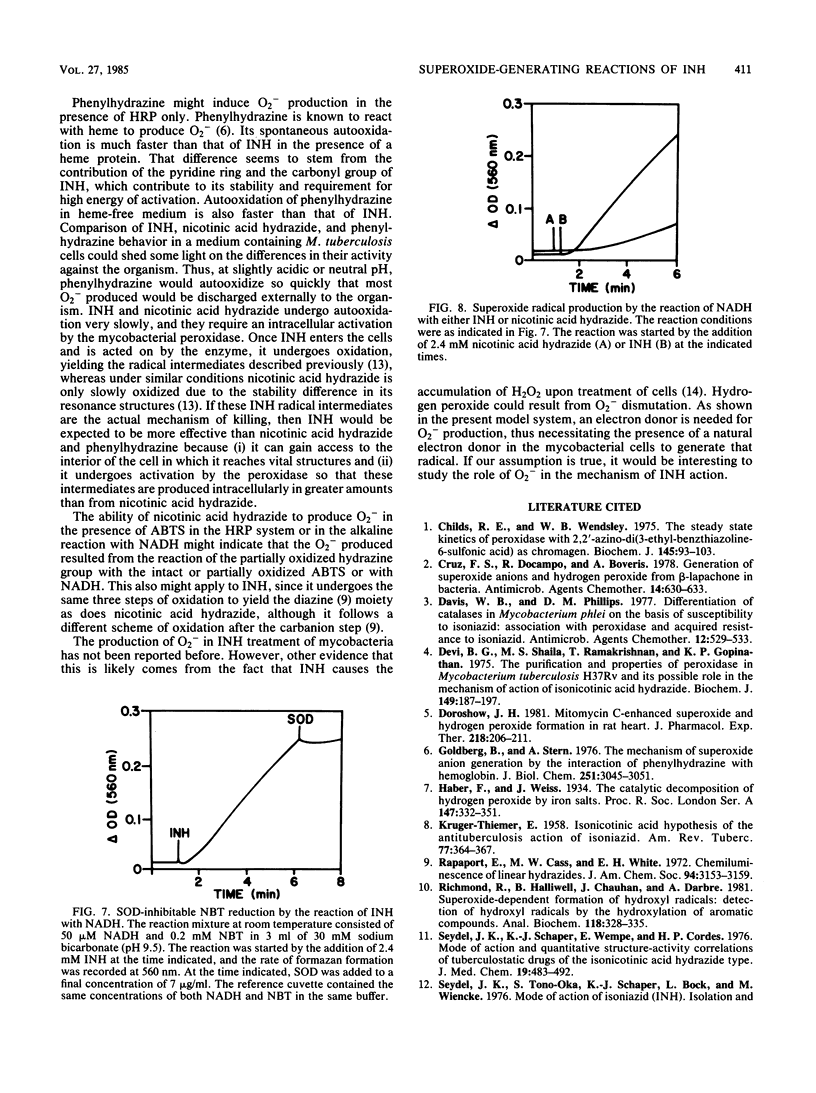Abstract
During the course of horseradish peroxidase-mediated oxidation of either o-dianisidine or 2-2'-azino-di(3-ethyl-benzthiazoline-6-sulfonic acid) (ABTS), no O2 consumption took place. When isonicotinic acid hydrazide (isoniazid) (INH) was included in the reaction mixture, O2 was consumed in amounts linearly related to the INH concentration. Nicotinic acid hydrazide at equimolar concentrations induced lower rates of O2 consumption. Superoxide dismutase activated O2 consumption. At equimolar concentrations, INH, nicotinic acid hydrazide, and phenylhydrazine induced bleaching of p-nitrosodimethylaniline in the horseradish peroxidase mediation of ABTS oxidation. Bleaching was not inhibited by hydroxyl radical (. OH) scavengers. After a short lag period, INH reacted with NADH at alkaline pH to produce superoxide radical (O2-), as detected by superoxide dismutase-inhibitable Nitro Blue Tetrazolium reduction. Nicotinic acid hydrazide with NADH caused a lower rate of O2- production after a longer lag period than INH.
Full text
PDF




Selected References
These references are in PubMed. This may not be the complete list of references from this article.
- Childs R. E., Bardsley W. G. The steady-state kinetics of peroxidase with 2,2'-azino-di-(3-ethyl-benzthiazoline-6-sulphonic acid) as chromogen. Biochem J. 1975 Jan;145(1):93–103. doi: 10.1042/bj1450093. [DOI] [PMC free article] [PubMed] [Google Scholar]
- Cruz F. S., Docampo R., Boveris A. Generation of superoxide anions and hydrogen peroxide from beta-lapachone in bacteria. Antimicrob Agents Chemother. 1978 Oct;14(4):630–633. doi: 10.1128/aac.14.4.630. [DOI] [PMC free article] [PubMed] [Google Scholar]
- Davis W. B., Phillips D. M. Differentiation of catalases in Mycobacterium phlei on the basis of susceptibility to isoniazid: association with peroxidase and acquired resistance to isoniazid. Antimicrob Agents Chemother. 1977 Oct;12(4):529–533. doi: 10.1128/aac.12.4.529. [DOI] [PMC free article] [PubMed] [Google Scholar]
- Devi B. G., Shaila M. S., Ramakrishnan T., Gopinathan K. P. The purification and properties of peroxidase in Mycobacterium tuberculosis H37Rv and its possible role in the mechanism of action of isonicotinic acid hydrazide. Biochem J. 1975 Jul;149(1):187–197. doi: 10.1042/bj1490187. [DOI] [PMC free article] [PubMed] [Google Scholar]
- Doroshow J. H. Mitomycin C-enhanced superoxide and hydrogen peroxide formation in rat heart. J Pharmacol Exp Ther. 1981 Jul;218(1):206–211. [PubMed] [Google Scholar]
- Goldberg B., Stern A., Peisach J. The mechanism of superoxide anion generation by the interaction of phenylhydrazine with hemoglobin. J Biol Chem. 1976 May 25;251(10):3045–3051. [PubMed] [Google Scholar]
- Richmond R., Halliwell B., Chauhan J., Darbre A. Superoxide-dependent formation of hydroxyl radicals: detection of hydroxyl radicals by the hydroxylation of aromatic compounds. Anal Biochem. 1981 Dec;118(2):328–335. doi: 10.1016/0003-2697(81)90590-x. [DOI] [PubMed] [Google Scholar]
- Seydel J. K., Schaper K. J., Wempe E., Cordes H. P. Mode of action and quantitative structure-activity correlations of tuberculostatic drugs of the isonicotinic acid hydrazide type. J Med Chem. 1976 Apr;19(4):483–492. doi: 10.1021/jm00226a007. [DOI] [PubMed] [Google Scholar]
- Shoeb H. A., Bowman B. U., Jr, Ottolenghi A. C., Merola A. J. Peroxidase-mediated oxidation of isoniazid. Antimicrob Agents Chemother. 1985 Mar;27(3):399–403. doi: 10.1128/aac.27.3.399. [DOI] [PMC free article] [PubMed] [Google Scholar]
- THIEMER-KRUGER E. Isonicotinic acid hypothesis of the antituberculous action of isoniazid. Am Rev Tuberc. 1958 Feb;77(2):364–367. doi: 10.1164/artpd.1958.77.2.364. [DOI] [PubMed] [Google Scholar]
- WINDER F. Catalase and peroxidase in mycobacteria. Possible relationship to the mode of action of isoniazid. Am Rev Respir Dis. 1960 Jan;81:68–78. doi: 10.1164/arrd.1960.81.1P1.68. [DOI] [PubMed] [Google Scholar]
- Youatt J., Tham S. H. An enzyme system of Mycobacterium tuberculosis that reacts specifically with isoniazid. I. Am Rev Respir Dis. 1969 Jul;100(1):25–30. doi: 10.1164/arrd.1969.100.1.25. [DOI] [PubMed] [Google Scholar]
- Zinner K., Vidigal C. C., Durán N., Cilento G. Oxidation of isonicotinic acid hydrazide by the peroxidase system. The formation of an excited product. Arch Biochem Biophys. 1977 Apr 30;180(2):452–458. doi: 10.1016/0003-9861(77)90059-5. [DOI] [PubMed] [Google Scholar]


